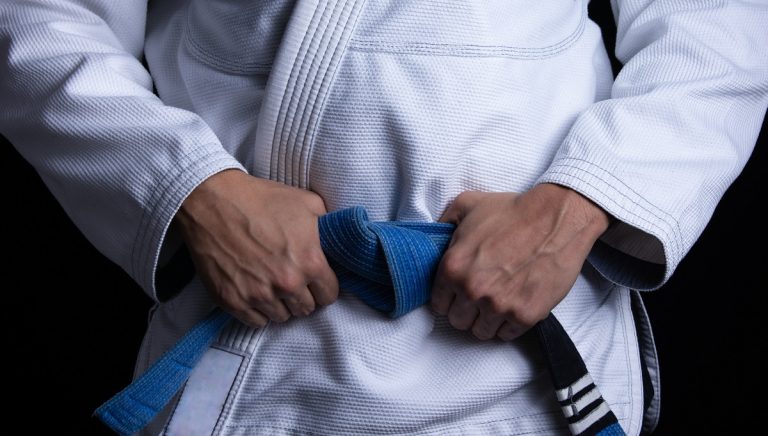Do MMA Fighters Lift Weights? (What Not to do When Weight Training for MMA)
Do MMA Fighters Lift Weights?
MMA fighters do lift weights. Weight training is an essential part of any fighter’s exercise routine, but it’s done with different goals in mind.
Unlike sports such as bodybuilding where the goal is to look aesthetically pleasing, MMA training focuses on building explosive strength and power with the goal to translate this into better performance in the cage.
UFC fighters will often have a consistent, periodized weight training programme specifically formulated for MMA. Each fighter will have a designated strength and conditioning coach in a team of many other people.
Why Do MMA Fighters Lift Weights?
At the elite level of fighting, MMA has a very small margin of error. For elite-level fighters, being competitive means maximizing every aspect of their technique, skill, power, endurance, and strength.
This means fighters need to lift weights to ensure the optimal strength and conditioning that’s needed during a grueling MMA fight.
Whilst MMA fighters lift weights, the frequency and type of training vary compared to bodybuilding. MMA weight training focuses on muscular endurance and explosive power compared to gaining muscle, with other factors such as weight cutting needing to be considered.
MMA fighters lift weights to achieve optimal strength relative to their body weight. MMA is physically demanding, with fighters needing to generate explosive power and speed to get up from the ground, wrestle against an opponent and generate the power needed for a knockout during the fight.
If a fighter neglects weight training, they won’t be able to generate the explosive strength and power needed at the elite level of MMA.
What Would an MMA Fighters Training Program Look Like?
During a fight, fighters often find themselves in 3 main positions:
- Stood up
- On the ground
- In the clinch
MMA weight training needs to simulate the mix of isometric and explosive movements performed during a fight transitioning between these main positions.
MMA Weight Training Exercises
A Lot of the focus when weight training for MMA will be on compound exercises that work the full body such as:
- Squats (Done with sandbags, dumbbells, kettlebells, or a barbell. High repetitions using bodyweight may also be performed)
- Deadlifts (Done with the same equipment as the squat, used to strengthen the posterior chain and increase power off the floor)
- Clean and Jerks (Done with a barbell or dumbbells. Builds explosive power throughout the whole body. This requires full body coordination and explosive power, both needed for MMA)
- Lunges (Done with a barbell, weights, or heavy sandbag. Lunges help to build muscular endurance, strength, and agility. The specific lunge movement helps with the explosive leg drive needed in the cage)
- Straight-Arm dumbbell press (This is done unilaterally to simulate the same movement as a punch. This exercise helps to increase punching power)
Other exercises to build grip strength, used for grappling will also be included in a good MMA weight training program such as:
- Weighted Carries (Done with heavy dumbbells, kettlebells, sandbags, or a trap bar. This exercise helps to increase forearm and grip strength, needed when grappling)
- Fat grip Pull Ups (Done using tennis balls or specific fat gripz to grip a pull-up bar. This exercise helps to build grip strength.
- Towel Hangs (Done by putting a tower over a bar and hanging from it for as long as possible. This exercise helps to further build vital grip strength)
Check out some examples of MMA strength building workout programmes.
How Often do MMA Fighters Lift Weights?
The frequency at which an MMA fighter will lift weekly depends on the fighter’s goals and specific training period.
Some fighters will lift weights every day whilst others will only do them 2-3 times each week. If the fighter is specifically preparing for an upcoming fight, training will be tapered down with the focus on adequate rest and the adaptations already made during the previous training block.
If the MMA fighter has a longer period between fights, they can focus more on the long-term build-up of strength and power, meaning the frequency of training would be higher.
Possible Drawbacks of Weight Training for MMA
When correctly planned, lifting weights can help to develop functional strength and power and translate into improved performance. However, the training needs to be performed to limit possible body mass increases, extremely important if you’re in a certain weight class.
With increases in muscle mass and weight, explosive speed and power tend to slow down, leaving the fighter more vulnerable in the cage.
As long as the MMA training program is properly planned, this won’t happen.
What Not to do When Weight Training for MMA
- Don’t focus on specific muscle groups (As stated above, the focus of MMA training should be on multi-joint compound movements designed to build explosive strength and power)
- Don’t focus on maximal lifting (The main goal of MMA training is building explosive strength and power, not achieving lifting PRs which could lead to injury)
Conclusion
MMA fighters lift weights as part of a well-designed, periodized training program. The weight training program is often designed by a strength and conditioning coach to improve the fighter’s explosive strength, power, and muscular endurance.
These improvements then translate into improved performance in the cage, with the weight lifting designed to mimic the isometric and explosive movements performed during a fight when transitioning between the main positions.
The strength and conditioning coach is part of a wider team of people whose job is to optimize the athlete’s performance.
FAQs
Does Lifting Weights Help During a Fight?
Lifting weights as part of a comprehensive MMA training program will help during a fight. The training program MMA fighters use is designed to build explosive strength, endurance, and power. This translates to better performance in the cage, with movements such as getting up from the ground, wrestling, and striking an opponent all done against resistance, which requires explosiveness.
Do MMA Fighters Have Rest Days?
On average, MMA fighters take 1-3 rest days per week. Due to the huge volume of training, resting is necessary to give fighters the time needed to recover.
Physically, muscle fibers need to be repaired after being broken down by a new training stimulus. Mentally, fighters need to rest and focus their minds making sure not to burn out from overtraining.
The amount of rest fighters take can change depending on the specific training goal or if they are preparing for a fight week.
Can You Build Muscle by Doing MMA?
You can build muscle doing MMA, but it won’t be optimal. Most MMA workouts are high-intensity, with a specific focus on muscular endurance, not muscle building.
When performing MMA movements like striking and kicking, you still use your muscles and build up more lean muscle mass and endurance, but it’s not going to make you pack on pounds of muscle compared to a sport such as bodybuilding.
Should MMA Fighters Lift Heavy Weights?
MMA fighters from beginners to elite athletes should include weight training as part of a comprehensive MMA program.
For an MMA fighter, the idea of training is to increase the training stimulus whilst working on fast, explosive movements. This means the main goal isn’t for the fighter to lift as heavy as possible, rather it’s to periodize their training in a way that allows for the training adaptations that translate into improved sports performance.
The weight training program needs to be designed in a way that complements, not takes away from the skills training.







